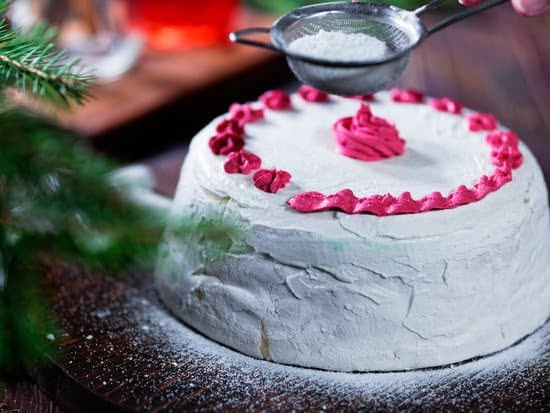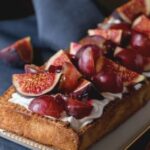In recent years, cake decoration has taken on a whole new level of artistry, with bakers around the world pushing boundaries and exploring innovative techniques. One trend that has captured the imagination of both amateurs and professionals alike is decorating cakes solely with fruit and flowers.
The juxtaposition of deliciously fresh produce and delicate blooms against the backdrop of a decadent cake creates a truly breathtaking visual display. But this trend isn’t just about aesthetics – it also brings with it a range of health benefits, adding vibrancy, nutrition, and flavor to traditional cake recipes.
Gone are the days when cake decoration was limited to sugary icing flowers or plastic figurines – today’s confectionery artists are opting for nature’s sweetest offerings instead. By using fruit and flowers as the primary decorative elements in their creations, they not only add vivid pops of color but also infuse cakes with an invigorating freshness.
Imagine slices of tangy citrus fruits adorning a fluffy lemon cake or plump strawberries nestled between layers of moist chocolate sponge – these natural additions not only enhance the beauty of a cake but also tantalize taste buds with their burst of flavors.
Furthermore, incorporating fruit and flowers into cake designs offers an array of health benefits. Fruits bring additional nutritional value to cakes, providing essential vitamins and antioxidants that can contribute to overall well-being.
Flowers, on the other hand, possess unique aromas and delicate flavors that can elevate an ordinary cake into something extraordinary. By thoughtfully selecting fruits and flowers that harmonize with the flavor profile of a cake, bakers can create desserts that are visually stunning, mouthwatering, and healthier alternatives to traditional options.
In this article, we will explore everything you need to know about using fruits and flowers in your cake decoration endeavors. From tips on choosing the perfect specimens to step-by-step guides on how to create beautiful arrangements, we’ll provide you with the knowledge and inspiration to embark on your own edible masterpiece. So, get ready to unleash your creativity and embrace nature’s sweetest gifts in cake decoration.
Benefits of Using Fruit and Flowers in Cake Decoration
Using fruit and flowers in cake decoration not only adds a visually stunning element to the design but also brings numerous benefits to both the appearance and taste of the cake. Incorporating these natural elements can elevate the overall aesthetic of the cake, making it more vibrant and appealing. At the same time, they impart a touch of freshness, making the cake even more enticing.
Adding Vibrant Colors and Freshness
One of the major benefits of using fruit and flowers in cake decoration is the burst of vibrant colors they bring. Fruits like berries, oranges, or kiwis can add pops of red, orange, or green to an otherwise monotonous color palette. Similarly, flowers like roses, lavender, or marigolds introduce mesmerizing hues like pink, purple, or yellow. The rich colors instantly transform a plain-looking cake into a visually striking masterpiece.
In addition to their visual appeal, fruits and flowers also infuse a sense of freshness into cakes. The natural aromas emanated by fruits and blossoms create an inviting scent that complements the sweetness of the cake. This freshness not only enhances the eating experience but also gives cakes an air of elegance that cannot be achieved through artificial decorations alone.
Nutritional Value and Flavor Enhancement
Another advantage of incorporating fruit and flowers in cake decoration is their added nutritional value. Unlike synthetic food dyes or artificial flavors which provide no substantial health benefits, fruits are packed with vitamins, antioxidants, and fiber that contribute to overall well-being. By using real fruits on cakes instead of artificial ingredients, bakers can offer healthier dessert options without compromising on taste or presentation.
Furthermore, both fruits and edible flowers possess unique flavors that can enhance traditional cake recipes. For example, adding sliced strawberries to a vanilla sponge cake provides a burst of juicy sweetness while rose petals can infuse delicate floral notes into a buttercream frosting. The subtle hint of these natural flavors adds depth and complexity to the taste profile of a cake, resulting in a more memorable and enjoyable eating experience.
Tips for Choosing the Perfect Fruit and Flowers for Cake Decoration
When it comes to decorating cakes with fruit and flowers, selecting the right ingredients is crucial in achieving a visually stunning and delicious result. Here are some valuable tips to keep in mind when choosing the perfect fruit and flowers for cake decoration:
- Select Fresh, In-Season Fruits: Opting for fresh, in-season fruits ensures that you get the best flavor and texture for your cake. Not only will these fruits be at their peak ripeness, but they will also provide vibrant colors that enhance the overall aesthetic appeal of your creation. Consider using berries like strawberries or blueberries for their bright hues or tropical fruits like mangoes or pineapples for a touch of exoticism.
- Complement Flavor and Design: The fruit you choose should not only match your desired color palette but also complement the flavor profile of your cake. For example, if you’re making a citrus-based cake, slices of tangy oranges or juicy lemons can add freshness and enhance the taste.
Additionally, consider how the shape and size of the fruit will fit into your design – smaller fruits like raspberries can be used as delicate accents while larger ones like slices of watermelon can make a bold statement. - Thoughtfully Select Flowers: When incorporating flowers into your cake decoration, it’s important to choose varieties that are safe to use on food products. Opt for edible flowers such as pansies, marigolds, or lavender blossoms that not only look beautiful but also offer pleasant flavors. Be sure to source your flowers from reputable suppliers to ensure they have not been treated with harmful chemicals.
- Properly Wash and Prepare Ingredients: Before using any fruit or flower in cake decoration, it’s essential to wash them thoroughly to remove any dirt or contaminants. Wash fruits under running water while gently rubbing them with your fingers to ensure they are clean.
Flowers should be carefully rinsed as well, and any excess moisture should be gently removed with paper towels. Remember to remove pistils, stamens, and any non-edible parts from the flowers before using them on the cake.
By following these tips, you can ensure that the fruit and flowers you choose for your cake decoration are not only visually appealing but also safe and flavorsome. Taking the time to consider factors such as freshness, flavor compatibility, and proper preparation will elevate your cake decor to a whole new level of artistry. Now that you have selected the perfect ingredients, let’s move on to exploring different techniques for incorporating fruit into cake designs in the next section.
Stunning Examples of Fruit Decorated Cakes
When it comes to cake decoration, the use of fruit as a primary decorative element has gained significant popularity in recent years. This trend allows bakers to create visually stunning and vibrant cakes that not only look beautiful but also tantalize the taste buds. From simple fruit accents to elaborate designs, incorporating fruit into cake decoration adds an extra touch of freshness and natural beauty.
One example of a fruit decorated cake is the classic summer fruit tart cake. This cake is typically adorned with a variety of freshly sliced fruits such as strawberries, kiwis, and blueberries. The combination of vibrant colors creates an eye-catching visual appeal that is perfect for warm weather celebrations or garden-themed events. The juicy fruits atop a crumbly crust add both texture and flavor to the cake, resulting in a refreshing and delightful treat.
Another impressive fruit decorated cake design is the cascading fruit tower. This design features tiers of delectable cake covered in luscious buttercream icing and adorned with an array of different fruits carefully arranged in a cascading pattern.
From raspberries and blackberries to slices of mango and pineapple, this design showcases the bountiful variety that nature has to offer. The combination of vivid colors against the white or pastel background creates a striking contrast that is sure to impress guests at any occasion.
For those seeking a more whimsical look, consider opting for a fruit patchwork design. In this style, individual sections or patches on the cake are filled with different types of fruits like peaches, apricots, grapes, or even pomegranate seeds.
These miniature “fruit gardens” bring together various textures and flavors within each slice and make for an intriguing visual display. With their colorful mosaic-like appearance, these cakes are a true work of art that celebrates the abundance and diversity found in nature’s gifts.
By integrating fresh fruits into cake decoration, bakers can elevate the overall aesthetic of their creations while adding a healthy and flavorful twist. The possibilities for fruit decorated cakes are endless, allowing for personalized designs that suit any occasion or theme. Whether it’s a birthday party, a wedding celebration, or simply a treat to enjoy with loved ones, fruit decorated cakes are sure to delight both the eyes and taste buds.
Captivating Flower Decorated Cakes to Wow Your Guests
When it comes to cake decoration, there are few things that can match the ethereal beauty of fresh flowers. Whether you’re planning a wedding, a birthday party, or simply want to impress your guests with a stunning dessert, incorporating flowers into your cake design is sure to wow everyone in attendance. In this section, we will explore a selection of captivating flower decorated cakes that are guaranteed to amaze and inspire.
One of the key benefits of using flowers in cake decoration is the instant elegance they bring. Flowers have always been associated with grace and beauty, and when arranged on top of a cake, they create a visually striking centerpiece. From delicate roses to vibrant sunflowers, there are countless varieties of blooms that can be used to complement your cake design and color scheme.
When decorating a cake with flowers, it’s important to consider different techniques for achieving the desired effect. Edible flowers are an excellent choice as they not only add beauty but also provide a subtle floral flavor.
You can press edible blossoms between sheets of wax paper or sugar them for an extra touch of sweetness and texture. Another approach is to create floral arrangements using non-edible flowers and secure them onto the cake using floral picks or food-safe wires.
To make sure you choose flower varieties that are safe for consumption, do thorough research or consult with a florist who specializes in edible blooms. It’s crucial to avoid toxic flowers or those that have been treated with pesticides. Additionally, remember that not all parts of the flower are edible – certain species may have pollen or stems that should be removed before use.
Including images showcasing these stunning flower decorated cakes will undoubtedly inspire readers with their unique beauty. Each description should highlight the specific flower varieties used and how they contribute towards creating an overall enchanting aesthetic on the cake.
Using HTML unordered lists:
- Incorporate various types of edible and non-edible flowers for a diverse and visually appealing cake design.
- Experiment with different techniques such as pressing, sugaring, or arranging flowers to create different effects.
- Remember to ensure the flowers chosen are safe for consumption and properly prepared before use.
By following these tips and exploring the possibilities of flower decorated cakes, you can unleash your creativity and create cakes that not only taste delicious but also leave a lasting impression of beauty and elegance.
Step-by-Step Guide
One of the most visually appealing and healthy ways to decorate a cake is by incorporating fruit. Whether it’s for a special occasion or just to indulge in a sweet treat, decorating a cake with fruit can add a vibrant burst of color and fresh flavor. In this step-by-step guide, we will walk you through the process of decorating a cake with fruit, from preparation to artistic arrangement.
- Preparation: Before you begin decorating your cake, it’s important to prepare the fruit properly. Start by selecting fruits that are ripe but still firm, as overly ripe fruits may become mushy and lose their shape on the cake. Wash the fruits thoroughly under cold running water and pat them dry with a paper towel.
- Placement: Once the fruit is prepared, decide where you want to place them on the cake. You can opt for arranging them in a neat pattern or scatter them randomly for a more whimsical look. It’s essential to consider the size and shape of the fruits when deciding their placement.
- Artistic Arrangement: Now comes the fun part – arranging the fruit on your cake. Use your creativity to create an aesthetically pleasing design. You can go for symmetrical patterns, like concentric circles or spirals, or create an organic arrangement that mimics nature’s beauty.
- Secure Attachment: To ensure that the fruit stays in place on top of the cake, you can apply a small amount of frosting or whipped cream as “glue.” Gently press each piece of fruit onto this layer of frosting to secure it in place.
Remember to refrigerate your decorated cake if it will be served later to keep the fruit fresh and prevent any potential spoilage. With these step-by-step instructions, you’ll be able to create a stunning and delicious masterpiece by decorating your cake with fresh fruit.
| Step | Description |
|---|---|
| Preparation | Select ripe but firm fruits, wash them thoroughly, and pat them dry. |
| Placement | Decide where to place the fruit on the cake – consider size and shape. |
| Artistic Arrangement | Create a visually appealing design using your creativity. |
| Secure Attachment | Add a small amount of frosting or whipped cream as “glue” and press each piece of fruit onto it. |
Step-by-Step Guide
Decorating a cake with flowers can add a touch of elegance and beauty to any occasion. Whether it’s a wedding, birthday, or simply a special gathering, incorporating fresh flowers into the cake design can create a stunning centerpiece that is sure to wow your guests. In this step-by-step guide, we will walk you through the process of decorating a cake with flowers, focusing on techniques such as pressing, sugaring, and arranging.
Step 1: Selecting the Right Flowers
When choosing flowers for your cake decoration, it is important to select varieties that are safe for consumption and free from pesticides. Opt for organic flowers from reputable sources or consider using edible blossoms such as pansies or violets. It’s always best to consult with a florist or horticulturist if you are unsure about the safety of a particular flower.
Step 2: Preparing the Flowers
Before placing the flowers on the cake, it is crucial to properly prepare them. Start by gently washing the blooms in cool water to remove any dirt or debris. Allow them to air dry completely before proceeding. If you want your flowers to have a more vibrant appearance, you can also lightly dust them with edible luster dust or powdered sugar.
Step 3: Attaching the Flowers
To securely attach the flowers to your cake, there are several methods you can use. One option is pressing the edible blossoms directly onto the frosting or fondant surface. Ensure that they are evenly distributed and avoid overcrowding one area. Another technique is using floral picks or toothpicks for larger blooms that may need extra support. Insert them into the stem end of the flower and then gently push them into the cake.
Step 4: Arranging and Styling
Now comes the fun part – arranging and styling your flower decoration. Consider creating floral clusters by grouping different blooms together in an aesthetically pleasing manner. You can also incorporate greenery or foliage to add depth and texture to the design. Play around with different arrangements until you achieve a look that you love.
By following these step-by-step instructions, you can confidently decorate a cake with flowers, transforming it into an exquisite masterpiece. Remember to handle the flowers with care and avoid placing them directly on cream fillings or delicate icings that may be easily damaged. The beauty and fragrance of fresh flowers will undoubtedly elevate your cake decoration, making it a true showstopper at any event.
| Step | Description |
|---|---|
| Step 1 | Selecting the Right Flowers |
| Step 2 | Preparing the Flowers |
| Step 3 | Attaching the Flowers |
| Step 4 | Arranging and Styling |
Delicious Recipes
When it comes to cake decoration, incorporating fruit and flowers not only adds visual appeal but also brings unique flavors to traditional recipes. By embracing nature’s sweetest gifts, you can create stunningly beautiful and delicious cakes that are sure to impress your guests. In this section, we will provide you with a collection of mouthwatering recipes that incorporate fruit and flowers into the cake batter or as part of the frosting.
- Lavender and Lemon Cake: This delicate and aromatic cake combines the floral notes of lavender with the zesty freshness of lemon. Infused with lavender syrup and paired with a tangy lemon buttercream frosting, this cake is both visually stunning and incredibly flavorful.
- Berry Blossom Cake: Bursting with summer flavors, this cake features layers of moist vanilla sponge filled with fresh berries and adorned with edible flower blossoms. The natural sweetness of the berries complements the delicate floral undertones, creating a harmonious blend of flavors.
- Citrus Garden Cake: This vibrant citrus-infused cake is topped with an assortment of candied citrus slices and edible flowers for a striking presentation. With layers of orange, grapefruit, and lime flavors, this cake is bright, refreshing, and perfect for warm weather celebrations.
- Tropical Paradise Cake: Transport yourself to a tropical paradise with this exotic fruit-inspired creation. Layers of pineapple cake are filled with coconut cream filling and decorated with an array of tropical fruits like mangoes, kiwis, and passionfruit to create a feast for both the eyes and taste buds.
- Rose Petal Cardamom Cake: For a touch of elegance, try this fragrant rose petal cardamom cake. The subtly spiced sponge is layered with rose petal-infused cream cheese frosting and garnished with crystallized rose petals for added beauty and flavor complexity.
These delicious recipes showcase just some examples of how you can incorporate fruit and flowers into your cake creations. Feel free to experiment with different flavor combinations and decorations to unleash your creativity and delight both yourself and your guests. So go ahead, embrace nature’s sweetest gifts, and create stunning cakes that are as beautiful as they are delicious.
Conclusion
In conclusion, the art of cake decorating with fruit and flowers offers a unique and visually appealing way to enhance cakes while also bringing health benefits. By incorporating vibrant fruits and beautiful flowers into cake designs, not only do we add pops of color and freshness, but we also introduce added nutritional value and flavor to traditional cake recipes.
The growing trend of using natural elements in cake decoration allows for endless creativity and the opportunity to create stunning, one-of-a-kind masterpieces.
When choosing the perfect fruit and flowers for cake decoration, it is important to select fresh, in-season ingredients that complement the flavors and design of the cake. Properly washing and preparing these elements is crucial for ensuring food safety. By following these tips, bakers can elevate their creations by incorporating the beauty of nature into their designs.
We have showcased a variety of exquisite cake designs that feature fruit as the primary decorative element. From delicate berry cascades to vibrant citrus slices, these stunning examples inspire imagination and demonstrate how fruit can be used as both a visual treat and a delicious topping.
Additionally, we have highlighted captivating flower decorated cakes that showcase how fresh flowers can add beauty and elegance to any cake. Techniques such as using edible blossoms or creating intricate floral arrangements allow for endless floral possibilities on cakes.
Frequently Asked Questions
How to decorate a cake with berries and flowers?
Decorating a cake with berries and flowers can create a visually stunning and delicious masterpiece. To start, ensure that your cake is baked and cooled completely before beginning the decoration process. First, gently wash and dry your chosen berries, such as strawberries or blueberries, removing any stems or leaves if necessary. Place them strategically on the cake, either in a pattern or randomly scattered across the top.
Next, select fresh edible flowers like pansies or lavender buds, making sure they are clean and free from pesticides. Carefully arrange the flowers to create an aesthetically pleasing design on your cake. Remember that some flowers may have a stronger flavor than others, so consider this when choosing combinations. If desired, you can add powdered sugar for an extra touch of sweetness or glaze to enhance the glossy appearance.
How do you decorate a cake without frosting?
Decorating a cake without frosting opens up a world of possibilities for those who prefer less sweet options or have dietary restrictions. One way to achieve an appealing decoration without frosting is by using glazes or syrups as alternatives. Create a simple glaze by mixing powdered sugar with milk or water until it has reached the desired consistency—thinner glazes will result in more delicate designs while thicker ones will hold their shape better.
Drizzle the glaze over the cooled cake using a spoon or squeeze bottle, allowing it to flow down the sides naturally. Alternatively, infuse your cake with flavorful syrups by brushing them onto each layer before stacking them together. This adds moisture and taste while lightly coating the surface for further decoration possibilities like dusting with cocoa powder or powdered sugar.
How do you decorate a plain cake with flowers?
Transforming a plain cake into an eye-catching masterpiece simply involves adding beautiful flowers as decorations. Begin by ensuring that your plain cake is baked and cooled completely before starting its embellishment. Choose edible flowers such as roses, violets, marigolds, pansies, or nasturtiums—just make sure they are free of pesticides. Gently wash and dry the flowers, removing any unwanted parts like stems or leaves.
Then carefully arrange them on top of your cake in a pattern that appeals to you. You may opt for a single flower as a focal point or create an intricate design using multiple varieties. Allow your creativity to flourish while arranging the flowers until you achieve a visually appealing look. Consider using different colors, sizes, and heights to add depth and interest to your plain cake’s presentation.

Welcome to our cake decorating blog! My name is Destiny Flores, and I am the proud owner of a cake decorating business named Cake Karma. Our mission is to provide delicious, beautiful cakes for all occasions. We specialize in creating custom cakes that are tailored specifically to each customer’s individual needs and tastes.





